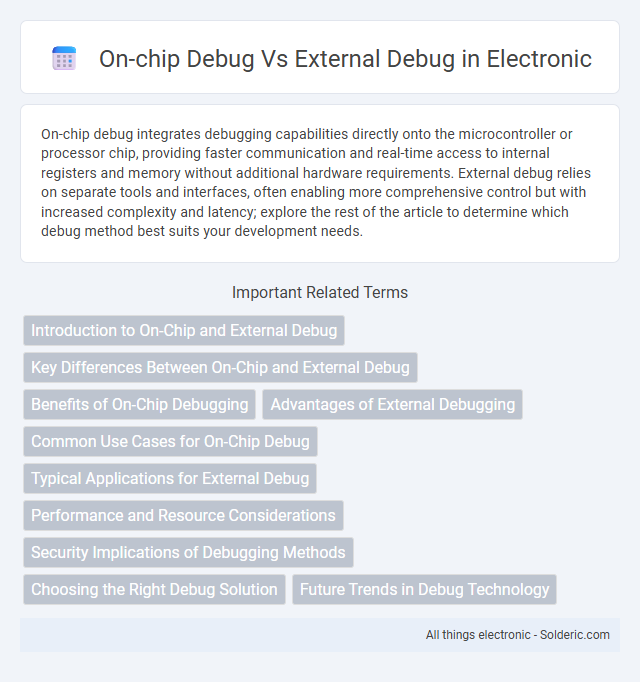On-chip debug integrates debugging capabilities directly onto the microcontroller or processor chip, providing faster communication and real-time access to internal registers and memory without additional hardware requirements. External debug relies on separate tools and interfaces, often enabling more comprehensive control but with increased complexity and latency; explore the rest of the article to determine which debug method best suits your development needs.
Comparison Table
| Feature | On-Chip Debug | External Debug |
|---|---|---|
| Integration | Built into the chip | Separate hardware device |
| Debug Interface | Internal debug port (e.g. JTAG, SWD) | External debugger connects via ports (USB, JTAG) |
| Cost | Lower, leveraged in silicon design | Higher, requires additional equipment |
| Performance Impact | Minimal, optimized for real-time debugging | Potentially higher latency due to external link |
| Debug Capabilities | Supports breakpoints, watchpoints, register access | Extended features depending on external tool |
| Setup Complexity | Simpler, no extra hardware needed | Complex, requires external setup and connections |
| Portability | Limited to chip with integrated debug | Flexible across multiple devices |
| Use Case | Embedded system development and on-chip troubleshooting | Comprehensive system-level debugging and diagnostics |
Introduction to On-Chip and External Debug
On-chip debug integrates debugging capabilities directly within the microcontroller or processor, allowing real-time access to internal registers and memory without halting system operations. External debug uses separate hardware tools like JTAG or SWD probes to interface with the device, providing more control but often requiring physical connection and system interruption. Choosing your debug method depends on the complexity of your system, real-time requirements, and the level of access needed for effective troubleshooting.
Key Differences Between On-Chip and External Debug
On-chip debug integrates debugging circuitry directly within the microprocessor, enabling real-time access to internal registers and memory with minimal impact on performance and board layout. External debug relies on dedicated hardware interfaces, such as JTAG or SWD, connected via pins or external connectors, which may introduce latency but provide greater flexibility for testing multiple devices or system-level diagnostics. On-chip debug supports non-intrusive monitoring and trace capabilities, whereas external debug is often more intrusive but better suited for system-wide troubleshooting and hardware validation.
Benefits of On-Chip Debugging
On-chip debugging offers real-time access to processor internals without the need for external hardware, enabling faster fault identification and resolution. Your development process becomes more efficient with integrated features like breakpoints, watchpoints, and trace capabilities directly within the chip, reducing system downtime and improving code quality. This seamless integration minimizes signal interference and wiring complexity compared to external debug tools, enhancing overall reliability and accuracy during debugging sessions.
Advantages of External Debugging
External debugging offers higher signal integrity and reduced noise interference by using dedicated hardware interfaces separate from the chip's internal circuitry. It allows real-time access to processor registers and memory without affecting the target system's operation, enabling accurate performance monitoring. External debuggers also support a wider range of devices and provide advanced features like complex breakpoint management and trace analysis unavailable in on-chip debugging.
Common Use Cases for On-Chip Debug
On-chip debug is commonly used for embedded system development, allowing real-time access to the processor's registers and memory without halting the system. It is ideal for debugging firmware in microcontrollers, verifying peripheral functionality, and performing detailed system-level analysis during development. On-chip debug tools provide low-latency control and visibility crucial for applications requiring precise timing and performance monitoring.
Typical Applications for External Debug
External debug tools are commonly used in complex system-on-chip (SoC) development and embedded system testing where real-time visibility and control over the device are crucial. They enable deep analysis of hardware behavior, firmware execution, and system-level integration, making them ideal for prototype validation, hardware bring-up, and debugging issues that are difficult to replicate with on-chip debug alone. Your development process benefits from external debug solutions when troubleshooting hardware-software interactions or performing low-level diagnostics that require non-intrusive access to the device.
Performance and Resource Considerations
On-chip debug offers faster access to internal processor states with minimal latency, enhancing real-time performance analysis while consuming limited additional chip resources. External debug interfaces may introduce communication delays and require extra hardware, impacting overall system speed and increasing resource overhead. Choosing on-chip debug optimizes performance-critical applications by integrating debugging capabilities directly into the silicon, reducing external dependencies and resource consumption.
Security Implications of Debugging Methods
On-chip debug interfaces often pose increased security risks due to direct access to internal processor states, enabling potential exploitation if not properly secured with authentication or encryption methods. External debug tools may offer enhanced isolation by connecting through dedicated ports, reducing the attack surface but could still expose system vulnerabilities if physical access is uncontrolled. Ensuring your embedded system's debug interface is protected via hardware locks, secure boot sequences, and tamper detection is crucial to safeguarding sensitive data during the development and maintenance phases.
Choosing the Right Debug Solution
Choosing the right debug solution depends on factors such as system complexity, cost, and ease of access. On-chip debug offers real-time, non-intrusive analysis directly within the silicon, ideal for embedded systems requiring detailed internal signal visibility. External debug provides broader compatibility and easier setup for system-level testing but may lack the fine-grained control and speed of on-chip methods.
Future Trends in Debug Technology
Future trends in debug technology emphasize the integration of AI-powered on-chip debug systems that enable real-time fault detection and predictive maintenance, enhancing testing efficiency. Advances in embedded trace modules and serial wire debug protocols further reduce the need for bulky external debug hardware, supporting higher data throughput and lower latency. Increased adoption of system-on-chip (SoC) architectures drives innovation toward hybrid debug solutions combining on-chip intelligence with cloud-based analytics for comprehensive system diagnostics.
on-chip debug vs external debug Infographic

 solderic.com
solderic.com